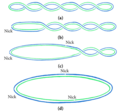Nick (DNA)
Nick (DNA) in Bacteria[edit]
A nick in DNA refers to a break in one of the two strands of the DNA double helix. This break involves the disruption of the phosphodiester bond between adjacent nucleotides, leaving the sugar-phosphate backbone of one strand intact while the other strand is severed. Nicks are significant in various biological processes, particularly in bacteria, where they play crucial roles in DNA replication, DNA repair, and genetic recombination.
DNA Replication[edit]
In bacterial DNA replication, nicks are essential for the initiation and progression of the replication process. The bacterial chromosome is typically circular, and replication begins at a specific location known as the origin of replication. During replication, the enzyme DNA helicase unwinds the double helix, creating a replication fork. As the replication machinery progresses, DNA polymerase synthesizes new DNA strands by adding nucleotides complementary to the template strand.
Nicks are introduced by DNA primase, which synthesizes short RNA primers that provide a starting point for DNA polymerase. These RNA primers are later removed, and the resulting gaps are filled by DNA polymerase. The enzyme DNA ligase then seals the nicks by forming phosphodiester bonds, completing the replication process.
DNA Repair[edit]
Nicks also play a critical role in bacterial DNA repair mechanisms. One of the primary repair pathways is base excision repair (BER), which corrects small, non-helix-distorting base lesions. In BER, a DNA glycosylase recognizes and removes the damaged base, creating an abasic site. An AP endonuclease then cleaves the DNA backbone at the abasic site, generating a nick.
The nick is further processed by DNA polymerase I, which removes the damaged region and fills in the gap with new nucleotides. Finally, DNA ligase seals the nick, restoring the integrity of the DNA molecule.
Genetic Recombination[edit]
In bacteria, genetic recombination is a process that allows for the exchange of genetic material between different DNA molecules, contributing to genetic diversity. Nicks are involved in homologous recombination, a type of genetic recombination that occurs between homologous DNA sequences.
During homologous recombination, the enzyme RecBCD processes double-strand breaks to produce single-stranded DNA with nicks. The single-stranded DNA invades a homologous DNA molecule, forming a D-loop structure. The enzyme RecA facilitates the strand exchange, allowing for the pairing of homologous sequences. Nicks are then sealed by DNA ligase, completing the recombination process.
Conclusion[edit]
Nicks in DNA are vital for various cellular processes in bacteria, including DNA replication, repair, and recombination. These processes ensure the maintenance of genetic information and contribute to the adaptability and survival of bacterial species.
See Also[edit]
References[edit]
- Alberts, B., Johnson, A., Lewis, J., Raff, M., Roberts, K., & Walter, P. (2002). Molecular Biology of the Cell. Garland Science.
- Lodish, H., Berk, A., Kaiser, C. A., Krieger, M., Bretscher, A., Ploegh, H., Amon, A., & Scott, M. P. (2016). Molecular Cell Biology. W. H. Freeman.
-
Effects of nicks on intersecting DNA forms
-
Ligase nick repair mechanism
Ad. Transform your life with W8MD's Budget GLP-1 injections from $75


W8MD offers a medical weight loss program to lose weight in Philadelphia. Our physician-supervised medical weight loss provides:
- Weight loss injections in NYC (generic and brand names):
- Zepbound / Mounjaro, Wegovy / Ozempic, Saxenda
- Most insurances accepted or discounted self-pay rates. We will obtain insurance prior authorizations if needed.
- Generic GLP1 weight loss injections from $75 for the starting dose.
- Also offer prescription weight loss medications including Phentermine, Qsymia, Diethylpropion, Contrave etc.
NYC weight loss doctor appointmentsNYC weight loss doctor appointments
Start your NYC weight loss journey today at our NYC medical weight loss and Philadelphia medical weight loss clinics.
- Call 718-946-5500 to lose weight in NYC or for medical weight loss in Philadelphia 215-676-2334.
- Tags:NYC medical weight loss, Philadelphia lose weight Zepbound NYC, Budget GLP1 weight loss injections, Wegovy Philadelphia, Wegovy NYC, Philadelphia medical weight loss, Brookly weight loss and Wegovy NYC
|
WikiMD's Wellness Encyclopedia |
| Let Food Be Thy Medicine Medicine Thy Food - Hippocrates |
Medical Disclaimer: WikiMD is not a substitute for professional medical advice. The information on WikiMD is provided as an information resource only, may be incorrect, outdated or misleading, and is not to be used or relied on for any diagnostic or treatment purposes. Please consult your health care provider before making any healthcare decisions or for guidance about a specific medical condition. WikiMD expressly disclaims responsibility, and shall have no liability, for any damages, loss, injury, or liability whatsoever suffered as a result of your reliance on the information contained in this site. By visiting this site you agree to the foregoing terms and conditions, which may from time to time be changed or supplemented by WikiMD. If you do not agree to the foregoing terms and conditions, you should not enter or use this site. See full disclaimer.
Credits:Most images are courtesy of Wikimedia commons, and templates, categories Wikipedia, licensed under CC BY SA or similar.
Translate this page: - East Asian
中文,
日本,
한국어,
South Asian
हिन्दी,
தமிழ்,
తెలుగు,
Urdu,
ಕನ್ನಡ,
Southeast Asian
Indonesian,
Vietnamese,
Thai,
မြန်မာဘာသာ,
বাংলা
European
español,
Deutsch,
français,
Greek,
português do Brasil,
polski,
română,
русский,
Nederlands,
norsk,
svenska,
suomi,
Italian
Middle Eastern & African
عربى,
Turkish,
Persian,
Hebrew,
Afrikaans,
isiZulu,
Kiswahili,
Other
Bulgarian,
Hungarian,
Czech,
Swedish,
മലയാളം,
मराठी,
ਪੰਜਾਬੀ,
ગુજરાતી,
Portuguese,
Ukrainian

